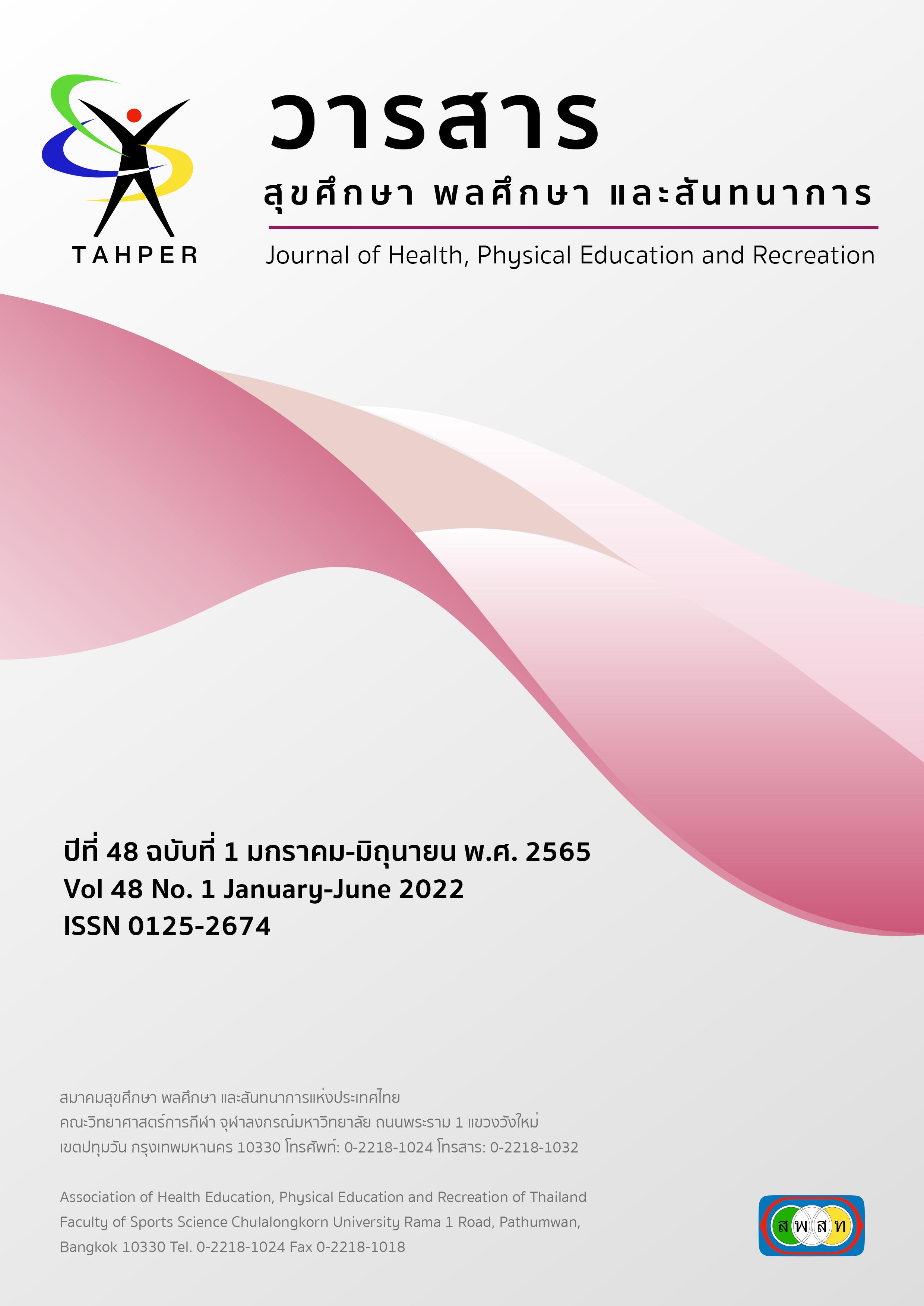ผลเฉียบพลันของการยืดกล้ามเนื้อแบบอยู่กับที่ แบบเคลื่อนที่ และแบบกระตุ้นการรับรู้ระบบประสาทกล้ามเนื้อ ที่มีต่ออาการเจ็บระบมกล้ามเนื้อ Acute Effects of Static, Dynamic and Proprioceptive Neuromuscular Facilitation Stretching on Muscle Soreness.
Main Article Content
Abstract
บทคัดย่อ
การวิจัยครั้งนี้มีวัตถุประสงค์เพื่อศึกษาผลเฉียบพลันของการยืดกล้ามเนื้อแบบอยู่กับที่ แบบเคลื่อนที่ และแบบกระตุ้นการรับรู้ระบบประสาทกล้ามเนื้อ ที่มีต่ออาการเจ็บระบมกล้ามเนื้อ ในกลุ่มตัวอย่างที่มีอาการเจ็บระบมกล้ามเนื้อจากการเล่นกีฬาแบดมินตัน ด้วยแบบประเมินมาตรวัดความปวดด้วยสายตา ที่ระดับ 6-7 อายุระหว่าง 20-22 ปี จำนวน 30 คน ด้วยวิธีการสุ่มอย่างง่าย แบ่งกลุ่มตัวอย่างออกเป็น 3 กลุ่ม โดยกลุ่มที่ 1 ได้รับการยืดกล้ามเนื้อแบบอยู่กับที่ กลุ่มที่ 2 ได้รับการยืดกล้ามเนื้อแบบเคลื่อนที่ และกลุ่มที่ 3 ได้รับการยืดกล้ามเนื้อแบบกระตุ้นการรับรู้ระบบประสาทกล้ามเนื้อ ทำการวัดอาการเจ็บระบมกล้ามเนื้อแบบกด (PPT) และเจาะเลือดหาค่าเอนไซม์ครีเอตินฟอสโฟไคเนส (CPK) ก่อนและหลังการยืดกล้ามเนื้อตามโปรแกรมที่กำหนด ทดสอบความแตกต่างระหว่างกลุ่มด้วยการวิเคราะห์การแปรปรวนทางเดียว (One Way Analysis of Variance: ANOVA) และวิเคราะห์ความแตกต่างภายในกลุ่มด้วยการทดสอบค่าที (paired t-test) กำหนดความมีนัยสำคัญทางสถิติที่ระดับ .05
ผลการวิจัยพบว่าอาการเจ็บระบมกล้ามเนื้อแบบกด (PPT) และค่าเอนไซม์ครีเอตินฟอสโฟไคเนส (CPK) ของการยืดกล้ามเนื้อทั้ง 3 แบบไม่มีความแตกต่างกันอย่างมีนัยสำคัญทางสถิติที่ระดับ .05 สำหรับ การวิเคราะห์ความแตกต่างภายในกลุ่ม พบว่า มีความแตกต่างอย่างมีนัยสำคัญทางสถิติที่ระดับ .05 เฉพาะ ค่าเอนไซม์ครีเอตินฟอสโฟไคเนส (CPK) ก่อนและหลังการยืดกล้ามเนื้อแบบกระตุ้นระบบประสาทกล้ามเนื้อ โดยค่าเฉลี่ยมีทิศทางที่เพิ่มขึ้น จึงสรุปได้ว่าการยืดกล้ามเนื้อแบบกระตุ้นระบบประสาทกล้ามเนื้อมีแนวโน้มทำให้อาการเจ็บระบมกล้ามเนื้อเพิ่มขึ้นได้
คำสำคัญ : การยืดกล้ามเนื้อแบบอยู่กับที่ แบบเคลื่อนที่ แบบกระตุ้นการรับรู้ระบบประสาทกล้ามเนื้อ อาการเจ็บระบมกล้ามเนื้อแบบกด เอนไซม์ครีเอตินฟอสโฟไคเนส
Abstract
This research was aimed to study the significant effects of the Static stretching (SS), Dynamic stretching (DS), and Proprioceptive neuromuscular facilitation stretching (PNFS) on the muscle soreness after badminton match. Subjects were 30 badminton players, age between 20-22 years old who were simple random sampling by muscle soreness test with VAS 6-7 and divided into 3 groups; 10 players for static stretching (SS), 10 players for dynamic stretching (DS), and 10 players for the proprioceptive neuromuscular facilitation stretching (PNFS). The parameters of the muscle soreness recovery were measured by using Pain Pressure threshold (PPT) and Creatine phosphokinase enzyme (CPK) level. One Way Analysis of Variance: ANOVA and paired t-test were used for statistical. Statistical significance was set at .05.
The results showed that the average number of Pain pressure threshold after these 3 muscular stretch-treatments did not statistically different, which was considered the same. According to the Creatine phosphokinase enzyme (CPK) level, the result from each treatment was significantly different, especially in PNFS treatment and its tended to cure the simultaneous muscle soreness for a bit. PNFS could stimulate the level of muscle soreness.
Keywords: Static stretching, Dynamic stretching, Proprioceptive neuromuscular facilitation stretching, Pain pressure threshold, Creatine phosphokinase enzyme
Article Details
Critical thinking in journals is the right of the author. The Association of Health Education, Physical Education and Recreation of Thailand is not always required, to create diversity in ideas and creativity.
ความคิด ข้อวิพากษ์ในวารสารเป้นสิทธิของผู้เขียน สมาคมสุขศึกษา พลศึกษา และสันทนาการแห่งประเทศไทยไม่จำเป็นต้องเห็นชอบด้วยเสมอไป เพื่อให้เกิดความหลากหลายในความคิดและความสร้างสรรค์


